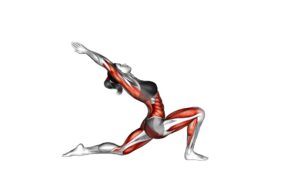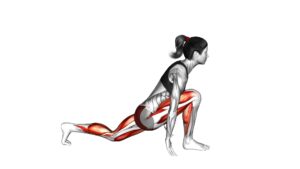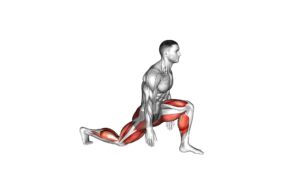Low Lunge (left) (female) – Video Exercise Guide & Tips

Get ready to tone and strengthen your lower body with the Low Lunge exercise.
Watch This Exercise Video
In this video exercise guide, you'll learn proper form and alignment for the left-sided Low Lunge, specifically designed for females.
Whether you're a beginner or advanced, we've got modifications and progressions for you. Avoid common mistakes and maximize your workout with our expert tips.
Let's dive in and take your fitness to the next level with the Low Lunge.
Key Takeaways
- Low lunge enhances overall fitness and flexibility.
- Proper form and alignment are crucial for maximizing benefits and preventing injury.
- Body positioning and modifications can be made to accommodate different needs, such as pregnancy or joint strain.
- Avoiding common mistakes and maintaining proper alignment is important for an effective low lunge exercise.
Benefits of Low Lunge for Females
Discover the benefits of the low lunge exercise for females and how it can enhance your overall fitness and flexibility. The low lunge is a versatile exercise that offers various variations for flexibility and improved hip mobility.
One of the key benefits of the low lunge exercise is its ability to increase flexibility. By performing different variations of the low lunge, you can target different muscles and improve your overall flexibility. For example, the low lunge with a twist helps stretch the hip flexors, quadriceps, and obliques, while the low lunge with a side bend focuses on stretching the hip flexors, hamstrings, and obliques. These variations can help you improve your range of motion, reduce muscle tightness, and prevent injuries.
Additionally, the low lunge is highly effective for improving hip mobility. This exercise specifically targets the hip flexors, which are often tight and can lead to discomfort or limited range of motion. By regularly practicing the low lunge, you can increase the flexibility and strength of your hip flexors, allowing for better movement and stability in your hips.
Proper Form and Alignment
To ensure proper form and alignment during the low lunge exercise, it's essential to focus on correct body positioning. This means keeping your front knee directly above your ankle and maintaining a straight back.
Avoid common mistakes such as leaning too far forward or allowing your knee to go past your toes. Remember, proper alignment is crucial for maximizing the benefits of the low lunge and preventing injury.
Correct Body Positioning
Maintain proper body positioning and alignment during the low lunge exercise to maximize its effectiveness. Here are a few key tips to help you achieve the correct form:
- Body Awareness: Pay attention to your body and how it feels during the low lunge. Keep your core engaged and your chest lifted to maintain a neutral spine. This will help you avoid straining your lower back and promote better balance.
- Modifications for Pregnancy: If you're pregnant, consider modifying the low lunge to accommodate your changing body. Use a wider stance to provide more stability and avoid going too deep into the lunge. Listen to your body and make adjustments as needed to ensure a comfortable and safe workout.
- Proper Foot Placement: Position your front foot directly under your knee, with the knee aligned over the ankle. This will help maintain stability and prevent any unnecessary strain on the joints.
Avoiding Common Mistakes
To ensure proper form and alignment in the low lunge exercise, focus on avoiding common mistakes and maintaining correct body positioning.
One mistake to avoid is allowing the front knee to go past the toes. This puts unnecessary strain on the knee joint. Instead, make sure the front knee is directly above the ankle.
Another mistake is collapsing the chest and rounding the shoulders. To improve, keep the chest lifted and the shoulders relaxed.
Additionally, avoid letting the back knee touch the ground. Keep a slight bend in the back knee to engage the leg muscles.
Lastly, be mindful of keeping the hips squared and facing forward throughout the exercise.
Importance of Proper Alignment
To ensure proper form and alignment in the low lunge exercise, it's important to consistently prioritize correct body positioning. Proper alignment not only helps prevent injuries but also maximizes the benefits of this exercise. Here are three tips for maintaining alignment:
- Maintain a straight back: Keep your torso upright and avoid leaning forward or backward. Engage your core muscles to support your spine and prevent excessive strain on your lower back.
- Align your front knee and ankle: As you lower into the lunge, make sure your front knee stays directly above your ankle. This alignment helps to protect your knee joint and ensures proper muscle activation in your legs.
- Square your hips: Keep your hips parallel to the front of the mat or floor. Avoid allowing your hip of the back leg to open outward. This alignment helps to engage the muscles evenly and prevents imbalances.
By following these tips, you can maintain proper alignment and get the most out of your low lunge exercise.
Now let's explore modifications for beginners.
Modifications for Beginners
Looking for easier modifications to try as a beginner? You're in the right place.
In this section, we'll explore some beginner-friendly variations of the low lunge exercise that can help you build strength and flexibility at your own pace.
Plus, we'll also highlight common mistakes to avoid, so you can get the most out of your practice.
Let's get started!
Easier Beginner Modifications
If you're new to low lunges, you can make the exercise easier by using a few modifications for beginners. Here are three ways to modify the low lunge to suit your fitness level:
- Use a block or a cushion: Place a block or a cushion under your front knee for added support and to reduce strain on your joints. This modification helps to decrease the intensity of the stretch.
- Shorten your lunge: Instead of taking a big step forward, try taking a smaller step. This will reduce the depth of the lunge and make it easier to maintain your balance.
- Use a chair for support: If you find it difficult to balance in the low lunge position, use a chair for support. Place your hands on the chair as you perform the exercise to help stabilize yourself.
Common Beginner Modification Mistakes?
When modifying low lunges for beginners, it's important to be aware of common mistakes that can hinder proper form and effectiveness.
One common modification mistake is failing to engage the core muscles. It's crucial to keep the abdominal muscles activated throughout the exercise to maintain stability and protect the lower back.
Another common error is allowing the front knee to extend past the toes. This puts unnecessary strain on the knee joint and can lead to injury. To avoid this, make sure to align the knee directly above the ankle during the lunge.
Lastly, beginners often neglect the proper alignment of the hips. It's important to square the hips to the front of the mat to ensure a balanced and effective low lunge.
Advanced Variations and Progressions
Once you have mastered the basic low lunge exercise, you can challenge yourself with advanced variations and progressions. These advanced modifications and lunge variations will help you take your workout to the next level and continue to build strength and flexibility.
Here are three options to consider:
- Weighted Low Lunge: Hold dumbbells or kettlebells in each hand while performing the low lunge. This added resistance will increase the intensity of the exercise and target your muscles even more.
- Jumping Low Lunge: Instead of stepping forward into the lunge, explode off the ground and switch your legs in mid-air. This plyometric movement will elevate your heart rate and engage your fast-twitch muscle fibers.
- Twisted Low Lunge: After lowering into the low lunge position, twist your torso towards the front leg and reach your opposite arm towards the ceiling. This will engage your obliques and enhance the stretch in your hip flexors.
By incorporating these advanced variations into your low lunge routine, you can continue to challenge yourself and see progress in your strength and flexibility.
Now, let's move on to the next section and discuss common mistakes to avoid for a safe and effective workout.
Common Mistakes to Avoid
To ensure a safe and effective workout, it's important to be aware of common mistakes to avoid while performing the low lunge exercise.
Proper form is crucial not only for maximizing the benefits of the exercise but also for avoiding injury.
One common mistake to avoid is allowing the front knee to extend past the toes. This puts excessive stress on the knee joint and increases the risk of injury. Instead, focus on keeping the front knee directly above the ankle, ensuring proper alignment and distributing the weight evenly.
Another mistake to avoid is collapsing the upper body forward. This not only reduces the effectiveness of the exercise but also puts strain on the lower back. To prevent this, engage your core muscles and maintain an upright posture throughout the movement.
Lastly, avoid rushing through the exercise and sacrificing proper form. Remember to take your time and focus on engaging the muscles of the lower body, specifically the glutes and quadriceps, to fully strengthen and tone them.
Tips for Maximizing the Low Lunge Workout
To maximize the effectiveness of your low lunge workout, incorporate these tips for optimal results:
- Modify the low lunge for different fitness levels: If you're a beginner, you can start by placing your back knee on a folded towel or yoga mat for added support. This will help you maintain stability and prevent strain on your joints. For intermediate or advanced levels, try adding weights by holding dumbbells or using a resistance band around your front leg. This will challenge your muscles and increase the intensity of the exercise.
- Explore variations to intensify the low lunge workout: Once you have mastered the basic low lunge, you can take it up a notch by incorporating different variations. One option is the pulsing low lunge, where you lower and lift your body slightly to engage your muscles even more. Another variation is the twist low lunge, where you rotate your torso towards the front leg, stretching and strengthening your core muscles.
- Focus on proper form and alignment: To maximize the benefits of the low lunge, pay attention to your form. Keep your front knee directly above your ankle, ensuring it doesn't extend past your toes. Engage your core muscles and maintain a straight back throughout the exercise. This will help you avoid unnecessary strain and injuries.
Frequently Asked Questions
How Many Calories Does a Low Lunge Workout Burn?
Low lunges are great for calorie burning and muscle strengthening. When performed correctly, they engage multiple muscle groups, including the glutes, quads, and hamstrings. This means your body works harder, resulting in more calories burned during the workout.
Incorporating low lunges into your routine can help increase your overall calorie expenditure and contribute to weight loss goals. So, if you're looking to burn calories and strengthen your muscles, low lunges are a fantastic choice.
Can Low Lunges Help With Improving Flexibility in the Hips?
Low lunges can be beneficial for improving flexibility in the hips. By incorporating low lunges into your exercise routine, you can stretch and strengthen the muscles in your hip area, which can lead to increased flexibility over time.
Additionally, low lunges also help in improving balance and strengthening the legs. Regularly practicing this exercise can be a great way to work on both flexibility and overall lower body strength.
Is It Safe to Practice Low Lunges During Pregnancy?
During pregnancy, it's important to modify your exercises to ensure safety. Low lunges can be practiced with some modifications to accommodate your changing body. They can help improve flexibility in the hips and strengthen the legs.
However, it's crucial to consult with your healthcare provider before engaging in any exercise routine during pregnancy. They can provide personalized guidance and ensure that low lunges are safe for you and your baby.
Can Low Lunges Help in Reducing Lower Back Pain?
Low lunges can be beneficial for reducing lower back pain. By incorporating low lunge modifications into your workout routine, you can stretch and strengthen the muscles in your lower back, hips, and legs, which can help alleviate pain and improve your posture.
These exercises target key muscle groups and promote flexibility, stability, and balance. Incorporating low lunges into your fitness routine can lead to improved overall posture and reduced discomfort in your lower back.
Are There Any Specific Breathing Techniques to Follow While Performing Low Lunges?
When performing low lunges, it's important to pay attention to your breathing. By incorporating specific breathing techniques, you can enhance the benefits of this exercise.
Deep inhales and exhales help to oxygenate your muscles and improve focus. As you lunge forward, inhale deeply, and as you return to the starting position, exhale fully.
This rhythmic breathing can increase your lung capacity and provide a calming effect during your workout.
Conclusion
In conclusion, the low lunge exercise is a beneficial workout for females, offering various modifications and advanced variations to suit different fitness levels.
By maintaining proper form and alignment, individuals can maximize the benefits and avoid common mistakes.
Incorporating the low lunge into your fitness routine can help improve flexibility, strengthen the lower body, and enhance overall fitness.
Remember to consult with a professional before starting any new exercise regimen.

Author
Years ago, the spark of my life’s passion ignited in my mind the moment I stepped into the local gym for the first time. The inaugural bead of perspiration, the initial endeavor, the very first surge of endorphins, and a sense of pride that washed over me post-workout marked the beginning of my deep-seated interest in strength sports, fitness, and sports nutrition. This very curiosity blossomed rapidly into a profound fascination, propelling me to earn a Master’s degree in Physical Education from the Academy of Physical Education in Krakow, followed by a Sports Manager diploma from the Jagiellonian University. My journey of growth led me to gain more specialized qualifications, such as being a certified personal trainer with a focus on sports dietetics, a lifeguard, and an instructor for wellness and corrective gymnastics. Theoretical knowledge paired seamlessly with practical experience, reinforcing my belief that the transformation of individuals under my guidance was also a reflection of my personal growth. This belief holds true even today. Each day, I strive to push the boundaries and explore new realms. These realms gently elevate me to greater heights. The unique combination of passion for my field and the continuous quest for growth fuels my drive to break new ground.







